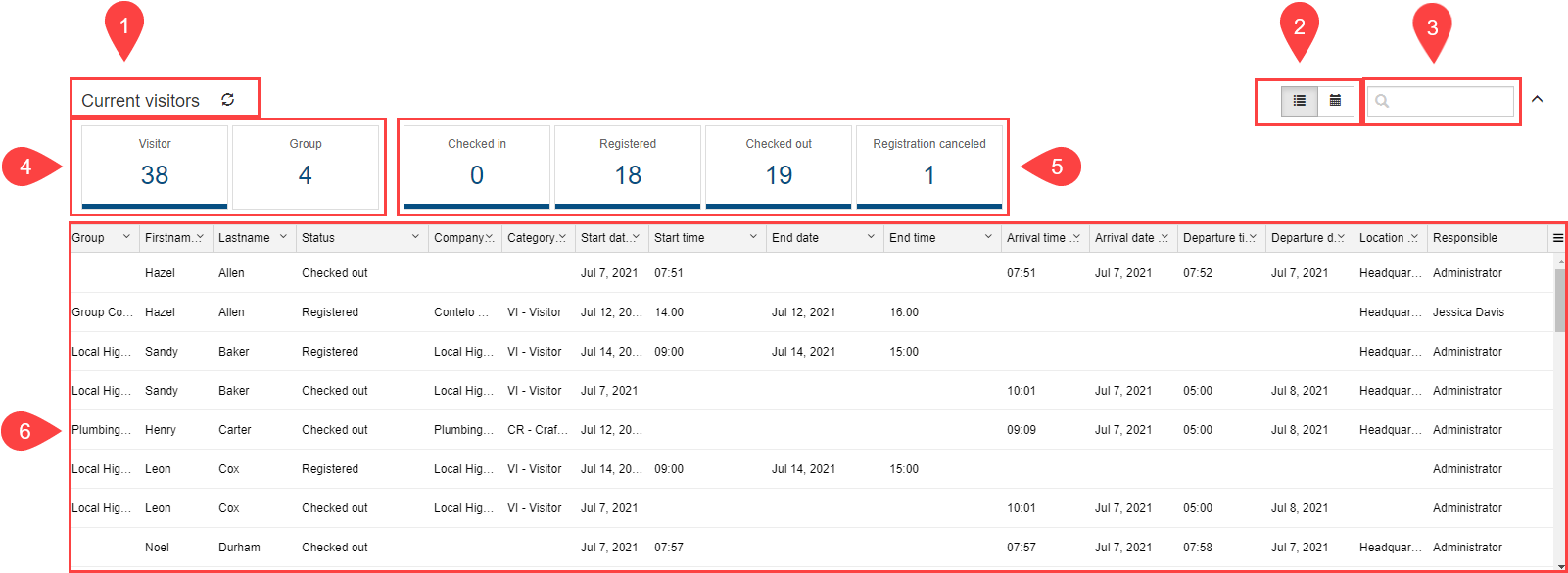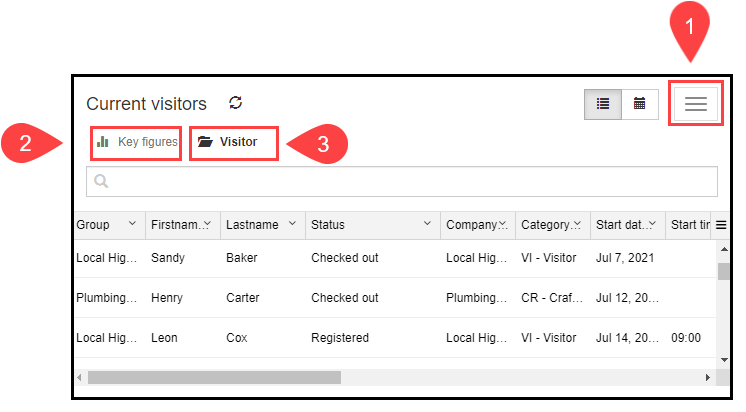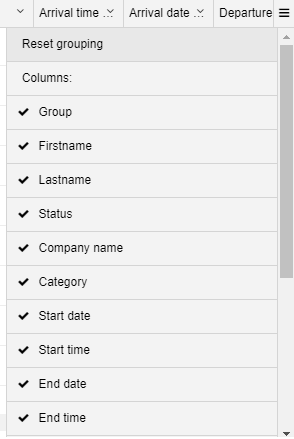# Dashboard overview
The dashboard provides an overview of all visitor files, group folders, and their statuses.
You can reach the dashboard by clicking the Visitors and groups tile in the My ELO area.
The dashboard remembers your settings. When you exit then open the dashboard again, it remembers and displays your most recent view.

Fig.: Dashboard in the table view
The dashboard is divided into the following areas:
1 Database: In the dashboard header, use the drop-down menu (arrow icon) to select a database. A dashboard database is a list of visitor files and/or group folders that is loaded for evaluation.
Information
If there is only one database, this database is selected permanently and no drop-down menu is available.
2 Table/Calendar: You can choose between two dashboard views: Table and Calendar.
3 Search: In addition to text values, you can also search for number values. All data that you can select as column values in the position view serves as the basis.
Information
If you'd like to search for index fields that are not listed on the dashboard, use the general ELO search.
4 Visitors/Groups: You can either view visitors or groups.
Information
When checking in a group, the group members are created as individual visitors. The individual group members are therefore shown when you select the visitor view. If you choose the group view, the groups are only shown with the person responsible.
5 Status: The dashboard header contains a button for each visitor status. If a button is active, all visitors with the corresponding status are shown in the dashboard viewer pane.
6 Viewer pane: In the dashboard viewer pane, you will see a list of visitor files or group folders. This list changes depending on the filter criteria applied.
# Minimized view

Fig.: Dashboard in minimized view
The dashboard automatically adjusts to the size of the browser window. Here, you see the view with a narrower width, where you can view either Key figures or Visitor.
1 Menu: You can hide and show the Key figures and Visitor as well as the free text search via the menu.
2 Key figures: Choose Key figures to view or change the status of the displayed visitors or groups.
3 Visitor: Select Visitor to show the visitors either in a table or calendar.
# Table

Fig.: Table view
Clicking an entry shows its preview. Double-clicking an entry brings you to the repository.
Customize the table view using the drop-down menus.
Fig.: Customizing the table view
The drop-down menus in the column headings contain the following functions:
- Sort ascending
- Sort descending
- Remove sorting: This option appears if you have sorted the column.
Alternative: You can sort the column by clicking the column heading. Clicking once sorts in ascending order. Clicking a second time sorts in descending order. Clicking a third time clears sorting.
- Hide column: The selected column is no longer shown in the table view.
- Group: The content of a column is joined into groups. The number of visitor files in each group is shown in brackets. Click the plus icon before the group to expand it and view all contained visitor files. The minus icon minimizes it again. Clicking the plus icon in the header expands all groups.
Information
You can combine multiple groups. You can specify a hierarchy with the order in which you select the columns.
- Ungroup: This option appears if you have grouped items. Click Ungroup to discard the group.

Fig.: Overview of all columns
Menu: You can show hidden columns. Clicking the Reset grouping button resets all groups.
# Calendar
Fig.: 'Year', 'Month', and 'Day' buttons
The calendar offers three options: Year, Month, and Day.
Data from the visitor file is shown in all views.

Fig.: Annual view
Year: The annual view shows the number of appointments each month. For more detailed information on a month, click the month.
Fig.: Month view
Month: The month view shows the number of appointments each day. For more detailed information on a day, click the day.
To preview a visitor file, click the date.

Fig.: Day view
Day: The day view lists the appointments for the selected day. It works in the same way as the table view.